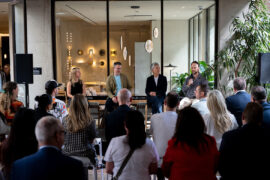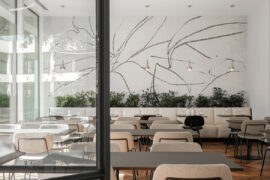Woods Bagot has been ranked as one of the fastest growing global design and consulting firms worldwide. Martine Beale asks Managing Director, Ross Donaldson about this, its One Global Studio philosophy, and sustainable development.

July 22nd, 2014
Since last year, Woods Bagot has risen 10 places and is now ranked seventh in Building Design’s 2014 World Architecture 100 list. What do you attribute this rise to?
All of our regions have experienced strong growth. In particular, in North America, where this year, business is the fastest growing and will be almost as large as the whole firm was in 2003. Also, around 50% of Woods Bagot’s revenue is from regions and sectors which did not exist in the business three years ago.
Our ‘Global Studio’ model enables strong market development in each of our regions, rather than being centrally controlled. This, combined with our heavy investment in knowledge development, brings value to our clients. As a result, we are finding that we are becoming highly competitive in securing major commissions in all our regions.
Can you tell us more about your One Global Studio philosophy?
Our One Global Studio approach gives each client full access to the combined professional talent and knowledge resources within the entire organisation, bringing all studios, disciplines and practices into a well-connected, highly coordinated and highly collaborative service network.
This network operates across five regions and allows us to combine local and global experts, virtually and physically, from any location to bring knowledge to projects of significance anywhere in the world.

Zhejiang University School of Management
Woods Bagot has utilised the latest technology to develop bespoke internal systems that allow the company to work collaboratively across borders. How did this come about?
We knew that we needed to capture the knowledge developed on projects and disseminate this quickly and seamlessly through all our 16 studios if we wanted the whole firm to work smarter and more efficiently. We could not find suitable platforms and products in the market so we set about building our own.
We have forged a partnership with Stanford University Engineering School to help unlock some aspects of the challenge to communicate globally across cultures.

National Australia Bank in Melbourne
What are your plans for breaking new ground in zero emissions architecture?
We have developed a number of initiatives in sustainable development with partner experts from different parts of the world. In the end, the market has to be willing to move on from the conventional.
There are any number of conferences and forums held each year, but governments must take the initiative to require higher performing buildings. They don’t necessarily have to be more expensive as we have proven with projects like the new building for the National Australia Bank at 700 Bourke Street in Melbourne.
You have driven major education projects on topics that include reducing carbon emissions and increasing sustainable design. How important are these to you?
Working on university and school projects is both a great privilege and a real pleasure in that, perhaps more than any other sector, these projects are about building a future for communities and nations.
Today, an equally important challenge is to develop models for a sustainable environmental future. These two challenges are partners – sustainable environments and communities, they are inseparable.
We had better get smarter in our ability to model longer term costs and benefits associated with investment in social and environmental sustainability.
What are your personal hopes for the future of urban development?
Large architectural practices like Woods Bagot have to take an increasingly responsible role in contributing to re-imagining the future of urban development rather than being passive contributors to the current trajectory, which is unsustainable, socially and environmentally.
In addition to driving higher performing individual buildings, we have forged partnerships like our recently signed agreement with Columbia University’s Graduate School of Architecture Planning and Preservation to undertake a series of focussed interrogations of the urban condition in four of the most challenging megalopolises in the world: Rio de Janeiro, Johannesburg, Istanbul and Mumbai. We have deliberately chosen four very different cities.
From this study, spanning two years, we hope to answer many questions about cities and city-making, starting afresh with groundbreaking ideas for urban environments of the future, across the world.
Woods Bagot
woodsbagot.com
INDESIGN is on instagram
Follow @indesignlive
A searchable and comprehensive guide for specifying leading products and their suppliers
Keep up to date with the latest and greatest from our industry BFF's!

A curated exhibition in Frederiksstaden captures the spirit of Australian design

A longstanding partnership turns a historic city into a hub for emerging talent

London-based design duo Raw Edges have joined forces with Established & Sons and Tongue & Groove to introduce Wall to Wall – a hand-stained, “living collection” that transforms parquet flooring into a canvas of colour, pattern, and possibility.

At Saltbox in Sydney, this year’s INDE winners – including a Best of the Best from Asia – were announced at an extravagant, fun Gala awards night.

Cox Architecture, Woods Bagot and Zaha Hadid Architects are all part of the newly completed Western Sydney International (Nancy-Bird Walton) Airport (WSI) terminal.
The internet never sleeps! Here's the stuff you might have missed

Curated by the Indesign editorial team and hosted at leading showrooms, the Design Discussions series provided thoughtful reflection and debate on key issues shaping the industry.

The CBD and South Melbourne Precinct promises a day of design experiences that balance movement, wellbeing, innovation and hospitality.

Hospitality is evolving fast, demanding interiors that can flex as quickly as guest expectations. From modular seating to stackable silhouettes, Bowermans brings global design brands and local know-how to help designers shape spaces that perform as well as they inspire.